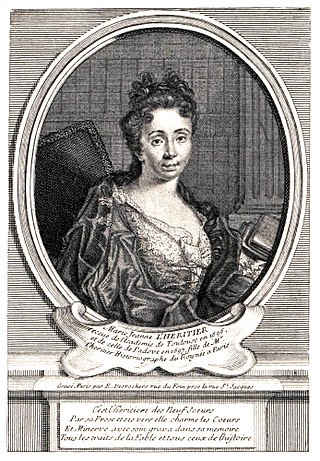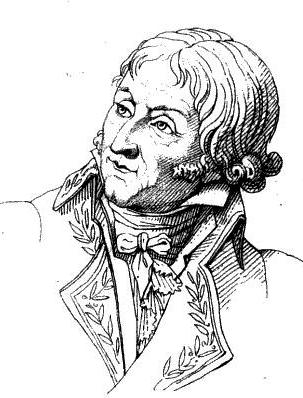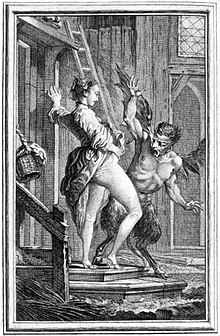
Jean Charles Emmanuel Nodier was a French author and librarian who introduced a younger generation of Romanticists to the conte fantastique, gothic literature, and vampire tales. His dream related writings influenced the later works of Gérard de Nerval.

Louis-Sébastien Mercier was a French dramatist and writer, whose 1771 novel L'An 2440 is an example of proto-science fiction.

Joseph Méry was a French writer, journalist, novelist, poet, playwright and librettist.
French Renaissance literature is, for the purpose of this article, literature written in French from the French invasion of Italy in 1494 to 1600, or roughly the period from the reign of Charles VIII of France to the ascension of Henry IV of France to the throne. The reigns of Francis I and his son Henry II are generally considered the apex of the French Renaissance. After Henry II's unfortunate death in a joust, the country was ruled by his widow Catherine de' Medici and her sons Francis II, Charles IX and Henry III, and although the Renaissance continued to flourish, the French Wars of Religion between Huguenots and Catholics ravaged the country.

François-Thomas-Marie de Baculard d'Arnaud was a French writer, playwright, poet and novelist. His series of novellas Les Épreuves du sentiment inspired Bellini's opera Adelson e Salvini.

Marie-Jeanne L'Héritier de Villandon was an aristocratic French writer and salonnière of the late 17th century, and a niece of Charles Perrault.

Jean-François Cailhava de L'Estandoux or d'Estendoux was a French dramatist, poet and critic.
Donatien Alphonse François de Sade, best known as the Marquis de Sade, was a French aristocrat, revolutionary and author of philosophical and sadomasochistic novels exploring such controversial subjects as rape, bestiality and necrophilia. His works evidence a philosophical mind advocating a materialist philosophy in which Nature dictates absolute freedom, unrestrained by morality, religion or law, with the pursuit of personal pleasure as its foremost principle. Besides novels, he wrote philosophical tracts, novellas, short stories, and a number of plays. Publication, dissemination, and translation of his works have long been hindered by censorship: not until 1983 were his works allowed unfettered distribution in the UK, for instance.

Louis Emmanuel Dupaty was a French playwright, naval officer, chansonnier, journalist and administrator of the Bibliothèque de l'Arsenal. His brother was the sculptor Louis Dupaty.
Claude-Sixte Sautreau de Marsy was a French journalist and man of letters.
Jean Vautrin, real name Jean Herman, was a French writer, filmmaker and film critic.

Jean de La Fontaine collected fables from a wide variety of sources, both Western and Eastern, and adapted them into French free verse. They were issued under the general title of Fables in several volumes from 1668 to 1694 and are considered classics of French literature. Humorous, nuanced and ironical, they were originally aimed at adults but then entered the educational system and were required learning for school children.
The French actor, writer, manager and director, Sacha Guitry had a prolific output of plays and films. His stage works range from historical dramas to contemporary light comedies. Some have musical scores, by composers including André Messager and Reynaldo Hahn. During the era of silent films Guitry avoided them, finding the lack of spoken dialogue fatal to dramatic impact. From the 1930s to the end of his life he enthusiastically embraced the cinema, making as many as five films in a single year.

Vers l'avenir, less commonly known by its Dutch title Naar wijd en zijd, is a Belgian nationalist song which was also the national anthem of the Congo Free State. Upon the annexation of the Congo Free State as a colony of Belgium, this anthem was replaced with La Brabançonne, the national anthem of Belgium. Vers l'avenir's lyrics were written by Gentil Theodoor Antheunis (1840–1907). It was also adopted as the anthem of the Rexist Party, a Fascist political movement founded in 1930 by Léon Degrelle.
Raymond Jean was a prolific French writer. He published more than 40 books in many genres, and won the Prix Goncourt de la nouvelle in 1983 for his book Un fantasme de Bella B. His novella La lectrice was turned into a hit film by director Michel Deville, starring Miou-Miou. It has been translated in English by Adriana Hunter for publication by Peirene Press, under the title Reader for Hire.
Joseph Aude was a familiar of Necker and Buffon whose biography he wrote as well as a comédie en vaudeville about his marriage, presented at the Société littéraire et scientifique d'Apt. Aude Joseph is considered an important author of the traveling theater of the early nineteenth, thanks to his Cadet Rousselle.
Louis d'Ussieux, real name Louis Dussieux, was an 18th-century French writer, historian, journalist, translator and agronomist.
Antoine-François Le Bailly, was a French librettist and fabulist.
La Bibliothèque oulipienne is a collection that hosts the works of the individual and collective members of the Oulipo. The short texts that compose them form a fabrique of playful literary creations.









